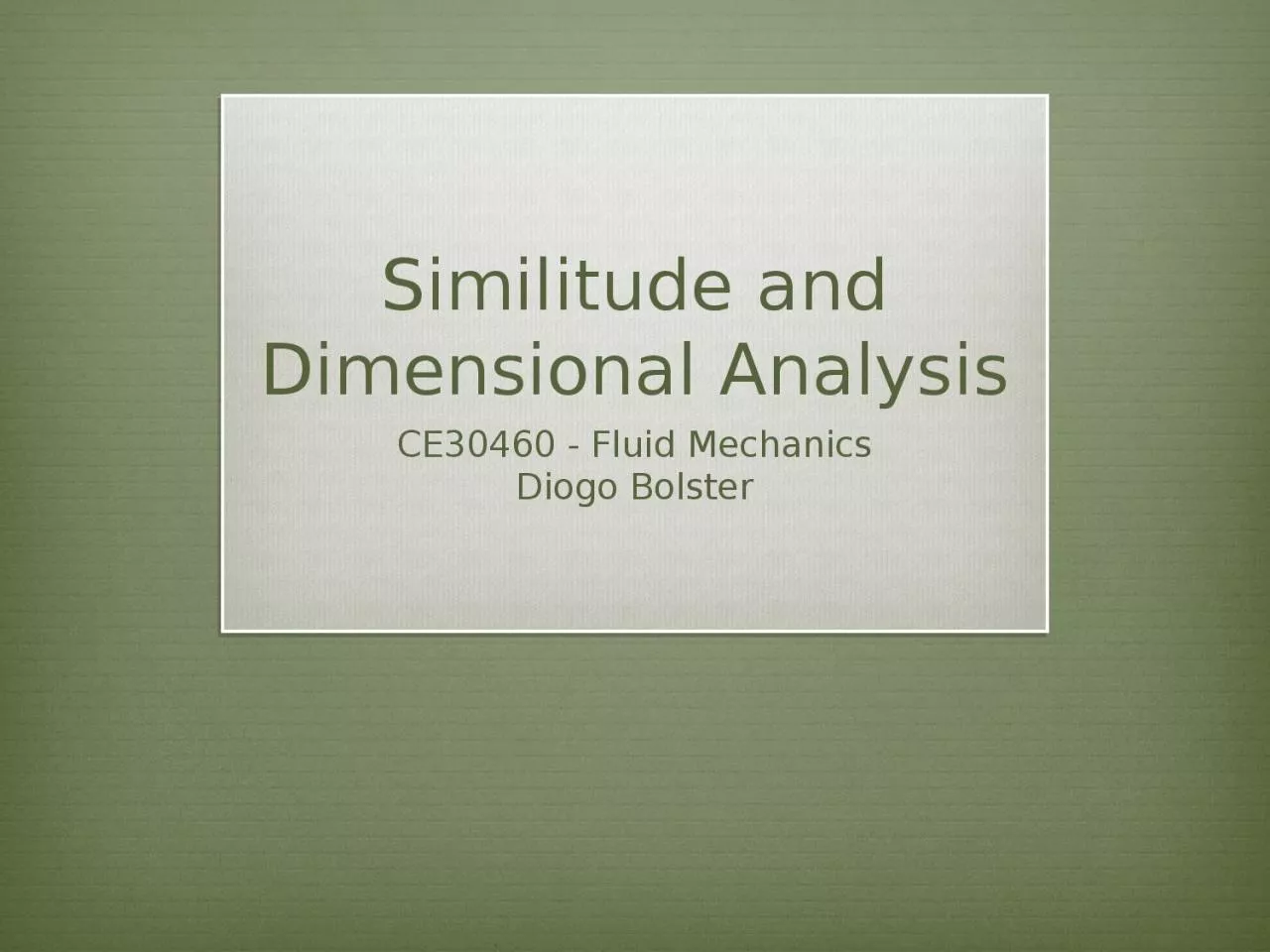

CE30460 Fluid Mechanics Diogo Bolster Goals of Chapter Apply Pi Theorem Develop dimensionless variables for a given flow situation Use dimensional variables in data analysis Apply concepts of modeling and similitude ID: 1026140
Download Presentation The PPT/PDF document "Similitude and Dimensional Analysis" is the property of its rightful owner. Permission is granted to download and print the materials on this web site for personal, non-commercial use only, and to display it on your personal computer provided you do not modify the materials and that you retain all copyright notices contained in the materials. By downloading content from our website, you accept the terms of this agreement.
1. Similitude and Dimensional AnalysisCE30460 - Fluid MechanicsDiogo Bolster
2. Goals of ChapterApply Pi TheoremDevelop dimensionless variables for a given flow situationUse dimensional variables in data analysisApply concepts of modeling and similitude
3. Basic PrinciplesDimensional HomogeneityIn a system with several variables one can construct a series of numbers that do not have dimensions. This inherently tells you something about the scale invariance or lack thereof of a problem…..
4. Units and Dimensions Important in FluidsPrimary DimensionsLength (L)Time (T)Mass (M)Temperature (q)For any relationship A=BUnits (A)=Units (B) Dimensional Homogeneity
5. Simple ExampleYou are studying the pressure drop per unit length in a pipeVariables: Dp, D, r, m, V (pressure drop per unit length, diameter, density, viscosity and velocity). If this is all we can hypothesizeDp=f(D, r, m, V )Dimensions: [Dp]=ML-2T-2, [D]=L, [r]=ML-3, [m]=ML-1T-1, [V]=LT-1
6. Example ContinuedDimensions: [Dp]=ML-2T-2, [D]=L, [r]=ML-3, [m]=ML-1T-1, [V]=LT-1I can combine these to form two dimensionless numbers(DDp)/(rV2) and (rVD)/(m)Therefore we can say (DDp)/(rV2) = F(rVD/m)We don’t know F, but we can look for it in data…..
7. Buckingham Pi TheoremI an equation involving k variables is dimensionally homogeneous, it can be reduced to a relationship among k-r independent dimensionless products where r is the minimum number of reference dimensions required to describe the variablesMathematically can be reduced to
8. Determination of Pi termsList all variables that are involved in the problemExpress each on in terms of primary dimensions (MLTq)Determine required number of Pi terms (each independent) – i.e. k-rSelect a number of repeating variables (equal to number of dimensions)Form pi terms by multiplying one of the nonrepeating variables by the product of repeating variablesRepeat last step for all nonrepeating variablesCheck that all resulting Pi terms are dimensionlessExpress in final form
9. Back to Simple ExampleApplying the Methodology outlined on the last slide (let’s do it on the board) we again obtain
10. By inspectionThe recipe listed before will always workTypically, we just do it by inspectionAll these numbers can be thought of as ratios of forces, ratios of timescales, ratios of lengthscales….
11. Sample Problem 1
12. Sample Problem 2
13. Sample Problem 3
14. Common dimensionless Groups in Fluids
15. Some interesting examplesHydraulic JumpDrag on a BoatTurbulent Flow in a Pipehttp://video.google.com/videoplay?docid=-5033243127531747249#
16. Data – Problems with One Pi TermIf only one term exists then according to the Pi Theorem we can say: P1=CAllows for a very nice relationship between variables and the constant can easily be fit from data….
17. Classical Example (Very slowly falling spherical particle – what is drag)Drag D = f (D,V,m)[D]= M L T-2[D]= L[V]= L T-1[m]= M L-1 T-1On one Pi group exists P1=D/(mVD)=COr D= m VDC 4 variables3 dimension
18. Sample ProblemWhen a sphere of diameter d=5 mm falls at a velocity of 0.1 m/s in water(viscosity=0.001 Ns/m2) it experiences a drag of 100 N.Can you develop a general law for drag on a sphere of arbitrary size in an arbitrary flow (for a slowing falling sphere)
19. Two of More TermsFor two terms P1=f(P2) P1=f(P2)Means when you have data you should plot P1 against P2 to deduce relationships or at least make best fits that can be used predicatively.
20. Sample Problem
21.
22. Sample Problem 2
23. Modeling and SimilitudeA model is a representation of a physical system that may be used to predict the behavior of the system in some desired respect, e.g.
24. Is this enough?
25. Types of SimilarityGeometric (ratio of length scales the same)Kinematic (velocity structures are the same)Dynamic (ratio forces the same)The best situation is: Get all dimensionless variables (Pi groups) the same between model and prototype. Then all similarities are preserved…..Sometimes hard to achieve it all….
26. ExampleConsider flow past some plate. You can to model dragPi theorem tells youTo ensure similarity w/h and rVw/m must be the same in model and prototype.If this is true D/w2rV2 is the same in model and prototype
27. 3 classical examplesFlow through Closed Conduits (Next Chapter)Civil Engineering ApplicationsFlow around Immersed Bodies (e.g. Buildings)Flow with a Free Surface (e.g. damns, hydroelectric)
28. Flow around bodiesWe are often interested in drag at high Reynolds number Coefficient of drag (what we want to measure in the lab)
29. Dimensionless NumbersCD – is dimensionlessReynolds Number (r V l/m)Ratio of all length scales (li/l)e.g. in golf ball depth of dimples over diameter of ballIn building width/height, window length/height, etc.Using Pi Theorem As long as the Reynolds numbers andlength scale ratios are the same in the model as the actual case (prototype) CD will the same
30. Relationship between Prototype and ModelWe can now calculate the drag on the prototype from measurements on the model.
31. Flow with a Free SurfaceGravity Driven Flows (i.e. water flows down a hill)As long as all other dimensionless numbers are matched between model and prototype Froude Number only matters (tough to do - e.g. Reynolds number – make large enough in both cases to not be important)
32.
33. Sample Problems
34. Data – Problems with One Pi TermIf only one term exists then according to the Pi Theorem we can say: P1=CAllows for a very nice relationship between variables and the constant can easily be fit from data….